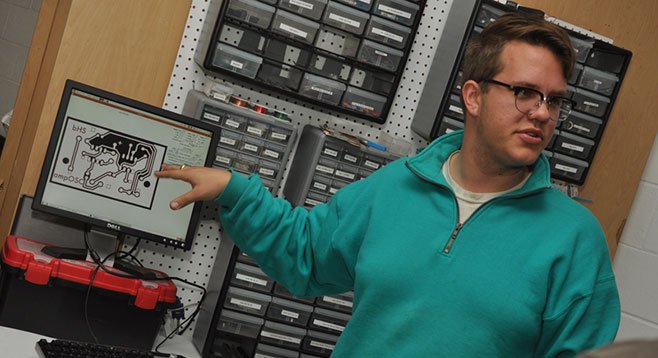 Facebook
Facebook
 X
X
 Instagram
Instagram
 TikTok
TikTok
 Youtube
Youtube

“The open-source movement and creative-commons licensing have been central to my ongoing learning and creative practice,” says computer-music grad student, educator, and do-it-yourself instrument designer Brendan Gaffney. Open-source software and creative-commons licenses offer alternative approaches to intellectual property that differ from a traditional capitalistic model in that often no money is exchanged.
“I’m always happy to share code, designs, work, and methods with other enthusiasts and educators, as I owe a great deal of my own work and passion for creation to the sharing of these materials by others,” explains Gaffney on the heels of his UCSD concert entitled 100 years of MIDI. (MIDI stands for musical instrument digital interface.)
One of the instruments he designed is called the Novo Sublimette, which works like a music box, reading the surface of cylindrical sleeves turning the information into musical notes. The sleeves were fabricated using a 3D printer, which can create semicomplex objects one layer at a time. Another interface Gaffney created is called the cusPi, which involves a Raspberry Pi microcontroller, the open-source visual programming language Pure Data, and a custom joystick.
“Everything will be set up for people to try and play, and I’ll have all the documentation on how people can do it themselves,” says Gaffney of his inventions, which will be on display at San Diego’s first Mini Maker Faire on December 7 at the Del Mar Fairgrounds.
Gaffney’s connection to the local “Maker” movement is largely based on his involvement with Fab Lab San Diego, where like-minded innovators, engineers, and entrepreneurs meet, design, and share knowledge and equipment every Saturday. When I paid a visit, Gaffney was giving a rundown on how to make printed circuit boards while demonstrations of other equipment, including 3D printers, were also taking place.
Although Gaffney utilizes and instructs others on how to use the latest technologies, he admits that he longs for “older new media.”
“I use a Macintosh SE, built in 1987, as one of my primary computers in performance...the first computer I used growing up. [It] still has my drawings in KidPix from my childhood. It also happens to be very good at creating simple MIDI interfaces, and the serial ports can plug straight into MIDI systems without converters. It has capabilities we ditched with modern computing, and it brings my own and others’ creative history back into the fold.”


“The open-source movement and creative-commons licensing have been central to my ongoing learning and creative practice,” says computer-music grad student, educator, and do-it-yourself instrument designer Brendan Gaffney. Open-source software and creative-commons licenses offer alternative approaches to intellectual property that differ from a traditional capitalistic model in that often no money is exchanged.
“I’m always happy to share code, designs, work, and methods with other enthusiasts and educators, as I owe a great deal of my own work and passion for creation to the sharing of these materials by others,” explains Gaffney on the heels of his UCSD concert entitled 100 years of MIDI. (MIDI stands for musical instrument digital interface.)
One of the instruments he designed is called the Novo Sublimette, which works like a music box, reading the surface of cylindrical sleeves turning the information into musical notes. The sleeves were fabricated using a 3D printer, which can create semicomplex objects one layer at a time. Another interface Gaffney created is called the cusPi, which involves a Raspberry Pi microcontroller, the open-source visual programming language Pure Data, and a custom joystick.
“Everything will be set up for people to try and play, and I’ll have all the documentation on how people can do it themselves,” says Gaffney of his inventions, which will be on display at San Diego’s first Mini Maker Faire on December 7 at the Del Mar Fairgrounds.
Gaffney’s connection to the local “Maker” movement is largely based on his involvement with Fab Lab San Diego, where like-minded innovators, engineers, and entrepreneurs meet, design, and share knowledge and equipment every Saturday. When I paid a visit, Gaffney was giving a rundown on how to make printed circuit boards while demonstrations of other equipment, including 3D printers, were also taking place.
Although Gaffney utilizes and instructs others on how to use the latest technologies, he admits that he longs for “older new media.”
“I use a Macintosh SE, built in 1987, as one of my primary computers in performance...the first computer I used growing up. [It] still has my drawings in KidPix from my childhood. It also happens to be very good at creating simple MIDI interfaces, and the serial ports can plug straight into MIDI systems without converters. It has capabilities we ditched with modern computing, and it brings my own and others’ creative history back into the fold.”
Comments